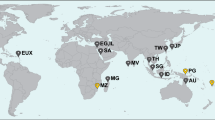Abstract
The widely accepted family tree of Scleractinia published by Wells, based on a combination of morphological coral taxonomy and the fossil record, has recently been revised by Veron. It is now possible to test the validity of some of the conclusions reached by these and other authors by the use of molecular techniques. This paper reviews the results to date. Studies of ribosomal DNA have shown that the Scleractinia are monophyletic, i.e. derived from the same ancestral taxon. Extensions of this same data set now indicate that the Poritidae and Dendrophylliidae, with their fossil antecedents, may each warrant separate suborder status. They further suggest (a) that the Suborder Faviina (faviids, mussids and their allies) should probably be retained as a monophyletic group and (b) that Wells' original account of the isolated position of the Pocilloporidae and Astrocoeniidae is correct. These conclusions all accord with Veron's family tree. However, the Fungiina, even after removal of the Poritidae, are unlikely to be a monophyletic group at suborder level. The molecular data further show that externally observable morphological characters used in the taxonomy of extant corals distinguish families more reliably than do internal micro-skeletal characters frequently used in coral palaeontology.
Similar content being viewed by others
References
Alloiteau J (1952) Madréporaires post-paléozoïques. Traité de Paléontologie 1:539–684
Alloiteau J (1957) Contribution á la systématiques des Madréporaires fossiles. CNR Sci, Paris
Beauvais L (1980) Sur la taxonomie des Madréporaires Mésozoïques. Acta Palaeontol Pol 25:345–60
Beauvais L (1984) Evolution and diversification of Jurassic Scleractinia. Palaeontographica Americana, 4th International Symposium on Fossil Cnidaria, Washington, pp 219–224
Beauvais L (1986) Evolution paléobiogéographique des formations á Scléractiniaires du Bassin téthysien au cours du Mésozoïque. Bull Soc Geol France 8:499–509
Beauvais L (1989) Jurassic corals from the circum Pacific area. Mem Assoc Austral Palaeontol 8:291–302
Budd AF (1986) Neogene paleontology in the northern Dominican Republic 3. The Family Poritidae (Anthozoa: Scleractinia). Bull Am Paleontol 90:47–123
Chen CA, Odorico DM, ten Lohuis M, Veron JEN, Miller DJ (1995) Systematic relationships within the Anthozoa (Cnidaria:Anthozoa) using the 5′-end of the 28S rDNA. Mol Phylogenet Evol 4:175–182
Chevalier JP, Beauvais L (1987) Classification en sous-orderes des Scléractiniaires. Traité de Zoologie 3:679–764
Cuif J-P (1980) Microstructure versus morphology in the skeleton of Triassic scleractinian corals. Acta Palaeontol Pol 25:361–374
Felsenstein J (1985) Confidence limits on phylogenies:an approach to the bootstrap. Evolution 39:783–791
Felsenstein J (1993) Phylogeny inference package (PHYLIP), version 3.53c. University of Washington, Seattle
Frost SH (1977) Oligocene reef coral biogeography, Caribbean and western Tethys. Bull Bur Rech Geol Minieres Mem 89:342–352
Gilbert DG (1992) SeqApp, a biological sequence editor and analysis program for Macintosh computers. Published publicly on Internet, available via anonymous ftp to ftp. bio. in-diana. edu.
Hand C (1956) On the evolution of the Actinaria. In: Ress WJ (ed) The Cnidaria and their evolution. Academic Press, London, pp 135–146
Higgins DG, Bleasby AJ, Fuchs R (1992) CLUSTAL V: improved software for multiple sequence alignment. Comput Appl Biosci 8:189–191
Matthai G (1928) A monograph of the recent meandroid Astreidae. Catalogue of Madreporarian corals. British Museum (Nat Hist) 7:1–288
Nemenzo F (1986) Corals. Guide to Philippine Flora and Fauna. Univ Philippines 5:1–273
Potts DC, Garthwaite RL (1990) Evolution of reef-building corals during periods of rapid global change. In: Dudley EC (ed) The unity of evolutionary biology. Proc 4th Int Cong Systematic Evolutionary Biol, Dioscoides Press, Portland, pp 170–178
Roniewicz E (1984) Aragonitic Jurassic corals from erratic boulders on the south Baltic coast. Ann Soc Geol Poloniae 54:65–77
Roniewicz E, Morycowa E (1989) Triassic Scleractinia and the Triassic/Liassic boundary. Mem Assoc Aust Palaeontol 8:347–54
Roniewicz E, Morycowa E (1993) Evolution of the Scleractinia in the light of microstructural data. Cour Forsch Inst Senckenberg 164:233–240
Swofford DL (1991) PAUP: phylogenetic analysis using parsimony, version 3.1. Computer program distributed by the Illinois Natural History Survey, Champaign, Ill
Vaugham TW, Wells JW (1943) Revision of the suborders, families and genera of the Scleractinia. Geol Soc America Special Paper 44:1–363
Veron JEN (1995) Corals in space and time:the biogeography and evolution of the Scleractinia. University of New South Wales Press
Veron JEN, Pichon M (1976) Scleractinia of eastern Australia. I. Families Thamnasteriidae, Astrocoeniidae, Pocilloporidae. Aust Inst Mar Sci Monogr Ser 1:1–86
Veron JEN, Pichon M, Wijsman-Best, M (1977) Scleractinia of eastern Australia. II. Families Faviidae, Trachyphyllidae. Aust Inst Mar Sci Monogr Ser 3:1–233
Veron JEN, Pichon M (1982) Scleractinia of eastern Australia. IV. Family Poritidae. Aust Inst Mar Sci Monogr Ser 5:1–159
Veron JEN, Wallace C (1984) Scleractinia of eastern Australia. V. Family Acroporidae. Aust Inst Mar Sci Monogr Ser 6:1–446
Veron JEN, Pichon M (1980) Scleractinia of eastern Australia. III. Families Agariciidae, Siderastreidae, Fungiidae, Oculinidae, Merulinidae, Mussidae, Pectiniidae, Caryophylliidae, Dendrophylliidae. Aust Inst Mar Sci Monogr Ser 4:1–422
Wells JW (1956) Scleractinia. In: Moore RC (ed) Treatise on invertebrate paleontology. Coelenterata. Geological Society of America and University of Kansas Press Kansas, pp 328–440
Wells JW (1966) Evolutionary development in the scleractinian family Fungiidae. Symp Zool Soc London 16:223–416
Wells JW (1986) A list of scleractinian generic and subgeneric taxa, 1758–1985. Fossil Cnidaria 15(11)
Yabe H, Sugiyama T, Eguchi M (1936) Recent reef-building corals from Japan and the south sea islands under Japanese mandate. Sci Rep Tohoku University Geol Ser 2 [Special vol] 1:1–66
Author information
Authors and Affiliations
Rights and permissions
About this article
Cite this article
Veron, J.E.N., Odorico, D.M., Chen, C.A. et al. Reassessing evolutionary relationships of scleractinian corals. Coral Reefs 15, 1–9 (1996). https://doi.org/10.1007/BF01626073
Accepted:
Issue Date:
DOI: https://doi.org/10.1007/BF01626073




